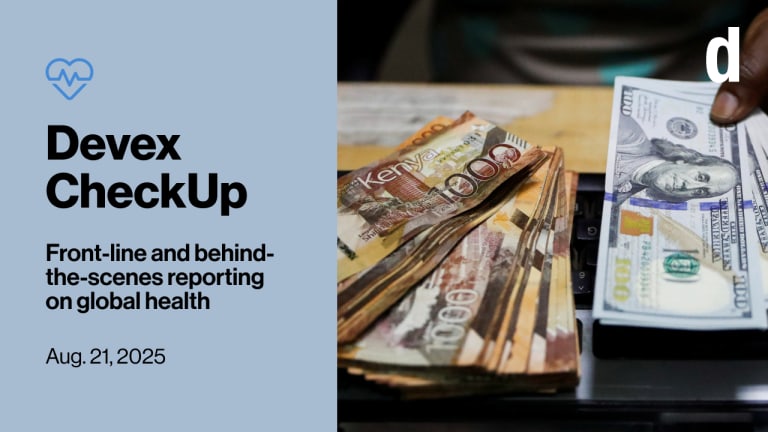
In Geneva this week, perhaps no other agenda item at the World Health Assembly seems so pressing, so frightening, so potentially global in reach, as antimicrobial resistance.
The race is on to prevent what the U.K. government recently termed the “catastrophic threat” of antibiotic-resistant “superbugs,” expected to kill up to 10 million people a year globally by 2050.
The World Health Organization has just appointed its first assistant director-general responsible for leading the global fight against AMR. Professor Hanan Balkhy has an unenviable task ahead of her.
One in 4 health care facilities globally without basic water service. One in 5 without decent toilets. One in 6 without soap and water for handwashing.
—Yet what worries me deeply is the lack of attention being paid to the most obvious, most basic preventive frontline defenses against superbugs: water, soap, and decent toilets. I know many Devex readers will roll their eyes at the predictability of WaterAid arguing for water, sanitation, and hygiene. But we do so because there are far too many failing to heed these warnings, and it collectively weakens all of us and threatens all of our futures.
I remember during conversations at last year’s World Health Assembly having moments of strange dissonance. So many of the issues under discussion were deeply connected to WASH, yet so few ministers, NGOs, or WHO staff were talking about this elephant in the room.
This year, they will debate the upcoming United Nations high-level meeting on universal health coverage. They will discuss the concepts of quality, equity, and dignity in health care. They will reflect on the notion of patient safety. They will review progress on AMR. I am delighted that they will also discuss WASH in health care facilities. But how many will connect the dots between these agenda items, especially when it comes to investments in health?
I hope many health ministers will have been shocked by the data released by WHO and UNICEF just a few weeks ago, which revealed the global status of WASH in health care facilities. I certainly was.
One in 4 health care facilities globally without basic water service. One in 5 without decent toilets. One in 6 without soap and water for handwashing. Hardly any countries with decent data on hospital cleaning.
Those statistics are stark enough. But when it comes to AMR, we are talking about a threat where we are literally only as strong as the weakest link in the global chain. So when the data shows that almost half of health care facilities in low-income countries lack basic water and that over 1.5 billion people have no choice but to use health centers without decent toilets, the precarious situation we are all in becomes clear.
WaterAid teams around the world have been acutely conscious of this danger. From Cambodia to Malawi to India, this crisis is real. We in Geneva, Switzerland, should be listening much more to those on the frontline.
They are the ears on the ground. And they know the impossible situation they are in. Many women are knowingly giving birth in dangerously unsafe conditions, and have to carry their own water in to clean themselves with. Many health workers who cannot rely on the availability of soap and clean water are overprescribing antibiotics as a prophylactic measure, contributing to the rising threat of resistance.
“The delivery room is a very dangerous place when there is no clean water or handwashing facilities,” said Sor Socheat, a hospital cleaner in Cambodia.
“I can’t wash my hands and I am treating one patient and then another — what we are doing is practically contamination,” remarked Hazel Claribel Sarante, a doctor in Nicaragua.
We must listen. In such horrible conditions, this is already a deadly issue on a daily basis. Take sepsis as an example. Globally, 225,000 babies die of sepsis in their first four weeks of life, most of those in sub-Saharan Africa and South Asia. Sepsis is frequently connected to births in an unclean environment. In Nepal, where an estimated 12,000 newborns die each year, the neonatal mortality rate is eight times higher than that of the U.K. A recent British Medical Journal study sounded the alarm that an epidemic of sepsis killing babies in South Asia is due in part to the “hot beds” of resistant infections found in most health facilities in the region.
This is a solvable problem. It is not a simple one, or a quick fix. But it cannot be ignored or neglected any longer if the ambition of “health for all” is to become reality. Countries of many different contexts and income-levels are taking action and showing that progress is possible.
WaterAid was pleased to contribute our experience to WHO and UNICEF’s “practical steps” report, published as a companion to the new data on WASH in health care facilities and summarizing very clearly eight tangible, specific actions countries can take to improve services.
At this year’s assembly, health ministers have the opportunity to address this issue head-on and to adopt an ambitious resolution, which could provide the cornerstone for a step-change in action.
The resolution process has been championed by the Africa region, spearheaded by the governments of Zambia, Tanzania, and Eswatini in particular. Earlier this year, countries such as Australia, Brazil, Indonesia, the United States, and the member states of the European Union added their support. There is momentum.
“First do no harm” is a founding principle of health care. It is not one we can afford to ignore now.








